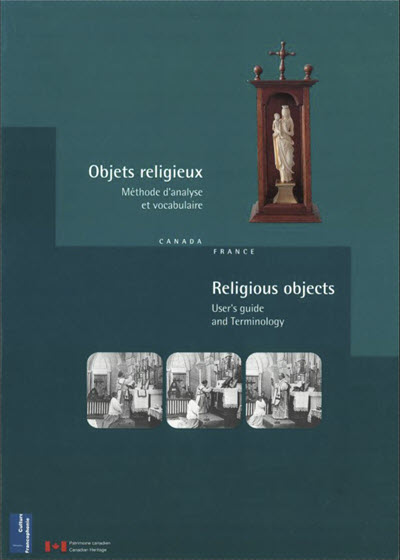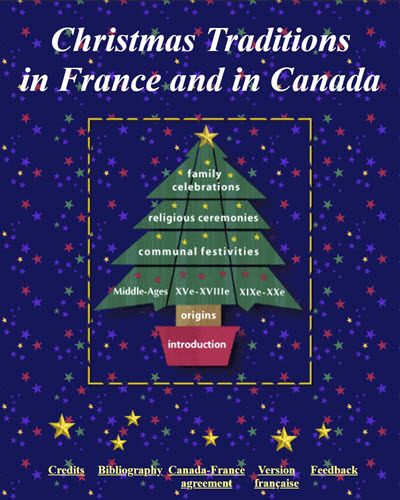Faith in Cyberspace: An Interview With Danielle Boily
By Alice Wang

© Government of Canada. 134608-0002
Figure 1. Danielle Boily speaking in a promotional video for the Canadian Heritage Information Network from the late 1980s.
Before virtual exhibitions and online collections were commonplace among cultural institutions, the Canadian Heritage Information Network (CHIN) had been helping Canadian museums and other heritage organizations build documentation capacities for their inventories since its inception in 1972. The advent of the Internet in the 1990s presented CHIN with a unique opportunity to evolve from a national repository of museum documentation to a promoter of Canadian cultural objects in cyberspace. In experimenting with the potential of the Internet, CHIN partnered with museums in Canada and France to create a virtual exhibition called “Christmas Traditions in France and in Canada” in December 1995. Danielle Boily was the CHIN director of this international collaboration. In celebration of the Canadian Conservation Institute and CHIN’s 50th anniversary, I spoke with Danielle about what it was like to work on CHIN’s first virtual exhibition, and the faith in cyberspace it required.
The interview has been edited for length and clarity.
Alice Wang (AW): CHIN collaborated with the French Ministry of Culture to launch “Christmas Traditions in France and in Canada.” What was the context leading up to this virtual exhibition in December 1995?
Danielle Boily (DB): When I was hired in 1982, CHIN had a mainframe computer and ran a software called PARIS (Pictorial and Artifact Retrieval Information System) to help Canadian museums document their inventories. Before PARIS, museums had to photocopy their catalogues or send in paper copies of their catalogues, and CHIN employees entered this data into the computer. Of course, the advent of the Internet in the early 1990s changed everything again.
Also in the early 1990s, we had completed a project with the religious communities of Quebec, helping them catalogue and document their religious objects. Based on that project, we published Religious Objects – User’s Guide and Terminology (1994) to help standardize vocabulary for religious object documentation. Using the guide, we worked with the Château de Versailles in France to help document some objects in the Louis XIV chapel. In doing so, we demonstrated that the guide worked!

© Government of Canada.
Figure 2. Objets religieux – Méthode d’analyse et vocabulaire | Religious Objects – User’s Guide and Terminology. Canadian Heritage, 1994.

© Government of Canada.
Figure 3. Home page of CHIN’s first virtual exhibit “Christmas Traditions in France and in Canada.”
But virtual exhibits were not part of CHIN’s original mandate from 1972, which focused on helping museums document their collections. So I had to find external funding to help finance the virtual exhibit whose technology was in its infancy. At the time, the Canada–France Agreement for Cooperation and Exchanges in the Field of Museology was celebrating its fifth anniversary. I applied for funding through the agreement and was successful!
AW: What was it like working on Canada’s first international virtual exhibit?
DB: It was exciting and a bit scary. We needed to create the content and implement the technology relatively quickly because we had to launch the virtual exhibit in a year.
The research involved collaboration among the Provincial Museum of Alberta (now the Royal Alberta Museum) in Edmonton; the Musée de la civilisation in the city of Québec; and the Musée national des arts et traditions populaires in Paris, France. Getting over 200 online images for the exhibit was a huge feat. A lot of museums weren't really familiar with the concept of a virtual exhibit, so obtaining the images to be put online was all done by hand, fax or courier. Nothing was sent over the Internet in those days.
For the technology, we had the support of the IT people at CHIN and the French Ministry of Culture. When we were ready to launch the exhibit at CHIN, we launched it in Montréal at Le Café Électronique, a café that was unique to Montréal at the time. There was a lot of hope and excitement, but people were also scared. At the time, France was going through a major strike. All the public transportation and all the civil servants in Paris were “frozen.” So that was very scary, and a lot of people went above and beyond to help make this happen.
We were also curious to see how the public would react. The first comments we got over the Christmas period were from parents and teachers. Parents wrote that they were excited: their children were looking at this exhibit! And the teachers were receptive as well. The Internet provided a lot of unreliable information, and one of the strengths of our exhibit was the credibility of the information. Everything was done by curators, double-checked and triple-checked. So teachers were quite open and also fascinated by the idea that they could use the information.
From this feedback, we knew there was something we needed to explore further. It was the beginning of virtual exhibits at CHIN. It was also the launching point for the Virtual Museum of Canada, which CHIN created in 2000.
AW: When CHIN launched “Christmas Traditions in France and in Canada” in December 1995, would you have imagined that virtual exhibits would become as common as they are today?
DB: Yes. I knew it was inevitable. Personally, I love science fiction. When you look at the planets or any other body in outer space, you cannot bring those things here; all that knowledge exists on the computer. And if you watch any episode of “Star Trek,” everything is on the computer. So the virtual space was something I really believed in personally, and a person had to have faith in those things in order to undertake the project.
AW: In a paper you co-authored about this exhibit, you ended with a quote by American architect Frank Lloyd Wright: “When an architect forces material on any form contrary to the nature of this material, the result is failure. It is not different in education nor is it different in human affairs.” Why did you include this quote?
DB: I included it to illustrate that the medium of the Internet was perfect for museum content. You can't force things. The medium has to fit with the content, and the medium of the Internet was perfect for the future of museum content.
AW: Thank you for sharing, Danielle. Any final thoughts?
DB: I had a wonderful career at CHIN. I feel like I had ten different jobs at CHIN because of how much the technology evolved. My career, and the careers of so many people at CHIN, evolved with the technology. We were always adapting. I think CHIN made such a big difference for the Canadian museum and cultural community. Even when I meet people today, they remember the impact CHIN has had.
To hear more personal reflections on what is was like to work for CHIN, tune in to the podcast CCI and CHIN: In Our Words and listen to the episodes with Peter Homulos and Lyn Elliott Sherwood.
Bibliography
Boily, D., and W.A. Thomas. “Virtual Exhibition Production: A Reference Guide.” In D. Bearman and J. Trant, eds., Museums and the Web 1998: Proceedings. Toronto, ON: Archives & Museum Informatics, 1998.
Boily, D., C.D. Guise and B. Goldstein. “An Internet Exhibition: ‘Christmas Traditions in France and in Canada.’ For Whom and Why?” In H. Kräutler, ed., New Strategies for Communication in Museums: Proceedings of ICOM/CECA 1996. Vienna, Austria: WUV Universitätsverlag, , 1997, pp. 57–61.
Léger, A.-M., and A. Vol. Evaluating and Monitoring the Internet Site “Christmas Traditions in France and in Canada.” Ottawa, ON: Canadian Heritage, 1997.
© Government of Canada, Canadian Conservation Institute, 2023
Cat. No.: CH57-4/71-2023E-PDF
ISBN 978-0-660-49177-6